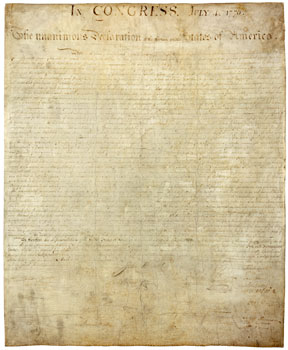Essay
We the People - A Bloody Encounter
"the people assembled in arms"

Both the Regulators and the Friends of Government believed they were the true defenders of the rights and freedoms described in the Declaration of Independence.
More info
Courtesy
The Declaration of Independence had exposed to "a candid world" in 1776 the actions of King George III, designed to impose "an absolute Tyranny" over the 13 states and their people. Following that declaration, Massachusetts and the other former colonies undertook the task of forming new, independent state governments to act as "Guards for their future security." By 1786, however, many Massachusetts citizens believed they were being treated as badly by the new state governments as they had been under Parliament and the King. The men who took up arms and closed down the judicial courts across the Commonwealth in 1786 argued that they were exercising their inalienable right to resist tyranny, a right and obligation clearly expressed in the Declaration of Independence: "But when a long train of abuses and usurpations, pursuing invariably the same Object evinces a design to reduce them under absolute Despotism, it is their right, it is their duty, to throw off such Government, and to provide new Guards for their future security."
On the eve of the action at the United States Arsenal at Springfield, Captain Luke Day of West Springfield sent a message to General William Shepard, the commander of the government militia encamped at the Arsenal. In this final ultimatum, Day, a veteran of the Continental Army, boldly spoke for "the people assembled in arms." Yet, General Shepard and the 1,200 militia under his command laid claim to the same revolutionary tradition. They, too, were the people assembled in arms. They had responded to the call of their government to defend it from the forces of anarchy and lawlessness. The citizens defending the Arsenal included veterans of the Continental Army and the state militia, while other Revolutionary War veterans bolstered the ranks of the advancing Regulators. Both sides believed they were defending the freedoms gained in the Revolution. The determination of the militia to defend the Arsenal matched the determination of the Regulators to seize it; the Arsenal artillery decided the contest.
| Print | Top of Page